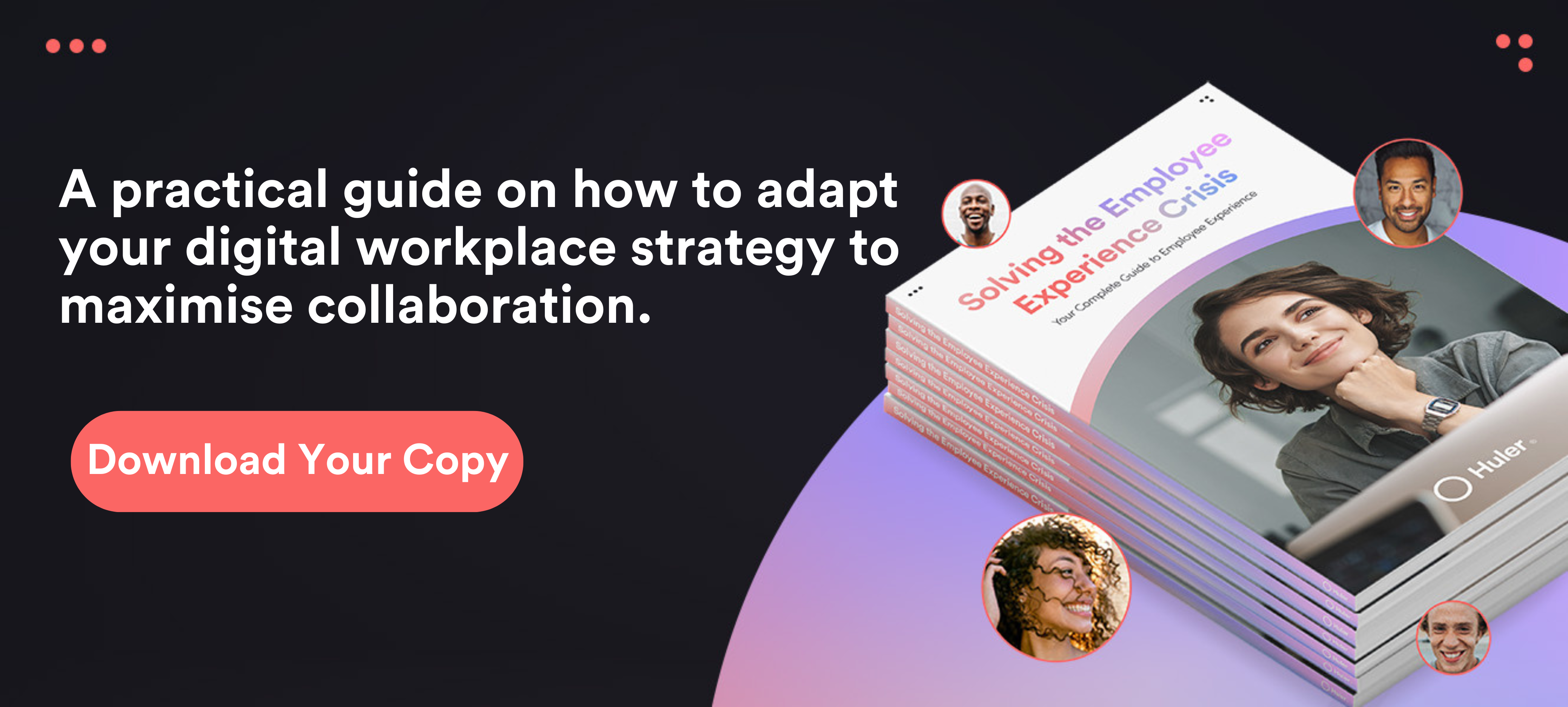Like it or lump it, the digital workplace is here to stay. Why? Well, to start with, your employees already use a suite of digital tools (ergo a digital workplace) every single day. Secondly, the world of work is rapidly changing. With hybrid working and work from anywhere models on the rise (hurrah!), organisations need to give employees everything they need to work smarter wherever they are. Which is where the digital workplace comes in.
We understand that investing in the workplace takes a lot of consideration. Your employees already use a tonne of different workplace technologies…Of course, you want to be sure you’re reaping all of the benefits a digital workplace has to offer while getting a solid return on investment. If you’re just starting to build a business case for implementing a structured digital workplace in your business, take a look at the 17 benefits you can stand to enjoy with the help of a digital workplace platform.
But wait! If you’re here and don’t know where to start, check out our full guide to get started: What Is A Digital Workplace?
17 Digital Workplace Benefits
Increased Flexibility and Agility
If there’s one thing the pandemic taught us it’s that being able to rapidly adapt to change is key to success. While events like COVID-19 don’t happen every day (thank goodness), the world is constantly changing little by little, whether it’s advances in technology, changes to legislation, shifts in customer needs, or evolving marketplaces.
An effective digital workplace strategy empowers both organisations and their employees with flexibility in all areas of their working life. For employees, a digital workplace empowers them to work from anywhere, on any device. This supports them to strike a work-life balance while being able to remain productive and connected.
For businesses, digital workplaces serve up the resources a workforce needs to be proactive, strategic and opportunistic in times of crisis, change or growth.
Improved Productivity
When your workforce is productive they are working efficiently towards the goals of the business. But how productive are your people? According to a recent survey, over three quarters of employees don’t believe that they are truly productive for an entire workday. So it’s likely they aren’t as productive as you think.
While alarming, what’s important is to consider why staff aren’t as productive as they could be. For example, it could be due to distractions in the physical office space. Phones ringing, interruptions and loud colleagues are all enough to put even the most dedicated off their stride. Poor productivity can also be attributed to overwhelm in the form of an overflowing inbox email, a jam-packed calendar, or a never-ending to-do list.
A digital workplace helps to eliminate some of the distractions and streamline the work processes that hinder time to productivity. They give employees the freedom to be intentional about where, how and when they work, which can help them knuckle down and get the job done when it’s needed most. As well as this, having everything in one place makes getting into the flow of work much quicker, as users don’t have to spend huge amounts of time locating information, logging in to different tools and asking around for the things they can’t find.
Less Time Wasted
Working efficiently means taking the quickest and most logical route towards an outcome. Technology has gone to great lengths to make us all more efficient. But it’s also a double-edged sword. Now we’ve reached the point where we have so much it can be hard to know where to start or what to do with it all.
Digital workplace platforms can help to streamline workflows and eliminate unnecessary distraction. They can also support artificial intelligence and machine learning solutions that aim to take the onus of time-intensive tasks away from employees.
In short, a digital workplace helps employees stop faffing around and get to doing the work that matters. Which in turn makes them happier, less stressed and more fulfilled. Winner!
Better Unified Communications
Effective, clear communication forms the foundation of a high-performing workplace. Sharing information, knowledge and ideas helps to avoid confusion, builds a positive culture, reaffirms company core values and creates a sense of accountability.
Digital workplaces like HulerHub make knowledge sharing and distributing company news and updates easy, especially for remote and distributed workforces. What’s more, they make finding information much simpler and quicker even when the searcher isn’t sure what they’re looking for, thanks to intelligent search features.
While there is a time and a place for email communication, having all relevant information stored and shared in one accessible platform makes keeping on top of everything much easier for even the busiest workforces.
Higher Levels of Creativity & Innovation
Inspiring creativity and innovation among employees can be difficult. Especially when they are bogged down by day to day activities. But both are essential for businesses to flourish and grow.
While a digital workplace can’t do the thinking for your staff, it can help to free up precious real estate in their minds and facilitate the two-way communication required to drive innovation and collaboration.
A Better Employee Experience
The employee experience is an important part of retaining talent and creating a high performing culture. As there are many different touchpoints in the employee journey, staying in control and enhancing the employee experience can be challenging, sometimes resulting in employees feel disengaged and unsatisfied.
A digital workplace can be utilised throughout the employee journey at various touchpoints to shape and support their experience. During the onboarding process it can be used to give new employees quick access to all of the information they need at a time where they are rapidly learning about their new role and company.
For development it can be used to showcase training and eLearning opportunities, prompting employees to take responsibility for their professional development.
Within remote, hybrid and distributed work models, digital workplaces can also be used to communicate relevant information to employees at the right time, keeping them firmly in the loop.
Talent Attraction
Attracting top talent isn’t easy, especially in such a competitive landscape. Over the past few years, many businesses have had to go to great lengths to refine and showcase what sets their workplaces apart from the rest. Employer branding, workplace culture, competitive salaries, flexible working and attractive benefits all form a key part of a candidate’s decision making process for choosing a new job.
While a digital workplace isn’t a recruitment tool, it does show a solid commitment to shaping a people-first workplace culture. Investing in a tool that allows employees to work flexibly, makes benefits accessible and facilitates easy, transparent, two-way communication is a signal to any potential employees that you’re serious about creating a great workplace culture and treating your people well.
Improved Employee Retention
Keeping hold of talented workers is getting harder and harder at the moment. What individuals want in the workplace (particularly millennials and gen-z) has changed radically and if employers can’t keep up they stand to lose out big time.
A digital workplace can help you keep hold of top talent by acting as a platform through which you can deliver what they want. As the employee experience improves and employee engagement increases, it’s likely that retention will also go up too.
Cost Savings
You know what they say…money makes the world go round. Happily, digital workplaces can go a fair way to reducing costs when implemented effectively.
If your teams are empowered to work from anywhere with the help of a digital workplace, you could end up spending a lot less on office space and travel. While there is always a time and a place for face to face interactions, unshackling employees from their desks and exploring alternative ways of collaborating (such as in a coworking space, at a coffee shop, or virtually) can result in significant cost savings and more meaningful interactions between colleagues.
On top of this, off the shelf flexible digital workplaces need no special IT configuration or training for users as it’s so intuitive to use and easy to set up.
Increased Collaboration
If employees can’t share knowledge and information easily, the can’t collaborate. The same is true if they don’t communicate with one another, or don’t feel like they are working towards a shared goal.
Digital workplaces make communication in a virtual environment a lot easier, especially for teams that might use quite a few different tools, apps and software to stay in touch. Within a platform like HulerHub, employees can easily share and keep track of documents and access team updates just like they would if they were in the office.
All of this makes working together much easier, which provides an environment in which collaboration can flourish.
Strengthened Workplace Culture
Creating an inclusive, strong workplace culture isn’t always easy. This is especially true in hybrid working environments where employees move between working remotely and on-site. A lack of regular contact with colleagues and the business as a whole can lead to employees feeling disengaged, disillusioned and unmotivated.
Digital workplaces help organisations communicate internally with employees regardless of where they work from. What’s more, they can be configured to push out only relevant news and information to the right people at the right time, which ensures that internal news and updates never get lost among the noise and always appeal to those who need to see them.
Increased Security
Cybersecurity threats, such as phishing, have become more prevalent since the start of 2020. It’s probably safe to say that many organisations have learned the hard way that having a distributed workforce accessing data, tools, software and content from different devices opens up a whole new world of security concerns and consideration.
A unified digital workplace can help to firm up newly implemented security measures with features such as Single Sign On to ensure user information and sensitive data doesn’t end up in the wrong hands.
Improved Customer Experience
The employee experience and the customer experience are undeniably linked. And it makes sense when you think about it. Employees who are motivated, fulfilled, have a good work life balance, and understand the core goals and value of the business are much more likely to provide a high level of customer experience. What’s more, they’re also likely to become brand advocates!
Eliminate Silos
When teams seal themselves off from the rest of the business, it creates workplace silos. If individuals are trapped in the silo mentality, they might not be able to problem solve or innovate effectively.
Digital workplaces can be used to support a unified vision that aims to eliminate silos by communicating core common goals, measuring employee engagement, encouraging collaboration, making knowledge sharing easy and facilitating interdepartmental innovation.
Happier Employees
Everyone likes to feel happy, and your employees are no different. If you’re aiming to create a people-first culture, prioritising the happiness, mental health and wellbeing of your employees should come pretty high on your to-do list. But it’s not all give and no take. Happy employees are:
- More productive
- Motivated to do their best
- Healthier
- Loyal
- Creative
Digital workplace platforms offer a medium through which to promote work-life balance, self-care and mental well-being. With the rise in remote work, the lines between personal and work life have become blurred resulting in more people working longer hours. But that only spells one thing: burnout. With a digital workplace, organisations can push content as part of your mental health at work strategy to employees in a timely way, ensuring it is front and centre at the point of need. They can also be used to monitor engagement and spot signs of burnout long before they happen, equipping managers with the foresight they need to step in and support their people.
An Empowered Workforce
Empowered employees are confident in their abilities and able to work autonomously. This means they can make decisions, problem solve and organise themselves with no need for micromanagement.
A digital workplace is the first step on your journey towards an empowered workforce. By giving them all the tools they need to work autonomously from anywhere, it demonstrates a level of trust in their abilities and can do wonders for their self-esteem and motivation.
Increased Revenue
Finally, when your employees are empowered and able to work from anywhere, they are more likely to be more productive, efficient, innovative and better at their job. What does that mean for your business? More money, of course!
At the end of the day, growth is key for any business regardless of size, industry or location. Your employees are a key part of that but they need to be equipped with the right tools and motivators to push ahead and get the jump on your competitors.
When implemented correctly alongside the right leadership and culture, a digital workplace can bring about all of the above benefits – and more. If you’re thinking about putting a digital workplace platform in place, or building on your existing set up, now is the time. The digital landscape is changing every day and new technologies are coming to the fore that could supercharge your business performance if you harness them quickly. But you and your employees need to make sense of them, or they risk overwhelming you.







